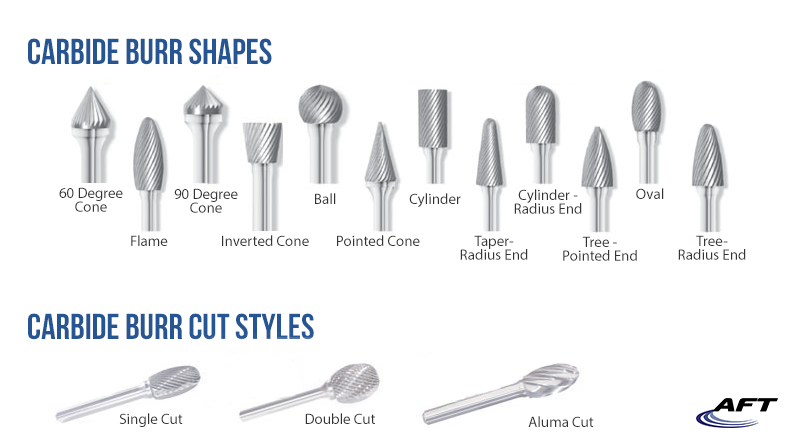Carbide Burrs
Carbide burrs, also known as carbide rotary burrs or burr bits, are cutting tools made from tungsten carbide. They are used for grinding, shaping, deburring, and removing material in various applications. Carbide burrs are commonly used in industries such as metalworking, woodworking, and automotive.
A carbide burr typically consists of a shank, which is a cylindrical metal piece that fits into a rotary tool such as a die grinder or a power drill. The cutting head of the burr is usually made of tungsten carbide, a hard and durable material that retains its sharpness even when used at high speeds.
Carbide burrs are available in various shapes and sizes, such as cylindrical, ball, oval, tree, cone, and flame. Each shape is designed for specific tasks and materials. For example, a cylindrical carbide burr is suitable for general-purpose grinding and deburring, while a ball-shaped burr is ideal for contouring and shaping.
When it comes to working with aluminum, using carbide burrs specifically designed for aluminum is recommended. These burrs typically have a high tooth count and a specialized geometry that helps prevent clogging and provides efficient material removal while minimizing heat buildup. Using the correct burr for aluminum ensures better results and reduces the risk of damage to the workpiece.
Carbide burr sets are available, which include multiple burrs with different shapes and sizes. These sets provide versatility and allow users to choose the appropriate burr for their specific applications.
AFT is proud to offer premium, American-made carbide burrs Norseman Drill & Tool, HTC and Champion Cutting Tool.
Burr Cut Styles
Carbide burrs come in several different cuts or flutes, which refer to the pattern and arrangement of the cutting edges on the burr's head. Each type of cut offers unique advantages and is suitable for specific applications. Here are some of the most common types of carbide burr cuts:
-
Single Cut (SA or S): Single cut carbide burrs have a single row of teeth arranged in a straight or spiral pattern. They provide a smooth cutting action and are ideal for general-purpose deburring, shaping, and light material removal. Single cut burrs are commonly used on softer materials like plastics, wood, and aluminum.
-
Double Cut (DA or D): Double cut carbide burrs have two sets of teeth arranged in a crossed pattern, forming diamond-shaped cutting edges. They provide faster material removal and a finer finish compared to single cut burrs. Double cut burrs are suitable for more aggressive grinding, deburring, and shaping tasks on metals, including stainless steel and cast iron.
-
Aluminum Cut/Aluma (ALU or A): Carbide burrs with an aluminum cut are specifically designed for working with aluminum and other non-ferrous metals. They have a high tooth count and a specialized geometry that helps prevent clogging and provide efficient material removal while minimizing heat buildup.
-
Diamond Cut (DC): Diamond cut carbide burrs feature a diamond-shaped pattern of teeth, similar to double cut burrs. However, the teeth have a larger spacing, resulting in a more aggressive cutting action. Diamond cut burrs are commonly used for rapid stock removal and heavy-duty applications on materials like cast iron, steel, and non-ferrous metals.
-
Chipbreaker Cut (CB): Chipbreaker cut carbide burrs have a unique design with serrated cutting edges. This cut helps break and remove chips more effectively, reducing the risk of clogging and improving cutting efficiency. Chipbreaker burrs are commonly used for shaping and smoothing hard materials like hardened steel and stainless steel.
-
Coarse Cut (CO or C): Coarse cut carbide burrs have larger and fewer teeth compared to other cuts. They are designed for aggressive material removal and are suitable for rough shaping and grinding tasks.
It's important to select the appropriate carbide burr cut based on the material and the specific application requirements. Using the right cut ensures efficient material removal, extended burr life, and optimal results.

